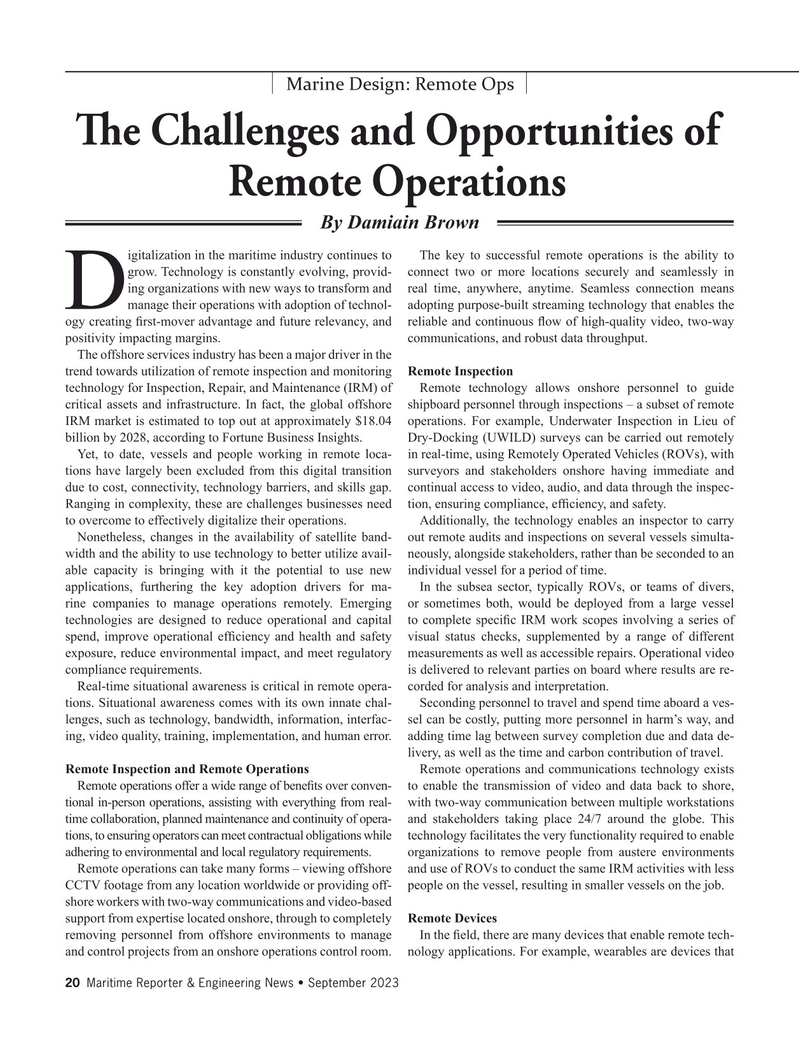
Page 20: of Maritime Reporter Magazine (September 2023)
Marine Design Edition
Read this page in Pdf, Flash or Html5 edition of September 2023 Maritime Reporter Magazine
Marine Design: Remote Ops
T e Challenges and Opportunities of
Remote Operations
By Damiain Brown igitalization in the maritime industry continues to The key to successful remote operations is the ability to grow. Technology is constantly evolving, provid- connect two or more locations securely and seamlessly in ing organizations with new ways to transform and real time, anywhere, anytime. Seamless connection means
Dmanage their operations with adoption of technol- adopting purpose-built streaming technology that enables the ogy creating ? rst-mover advantage and future relevancy, and reliable and continuous ? ow of high-quality video, two-way positivity impacting margins. communications, and robust data throughput.
The offshore services industry has been a major driver in the trend towards utilization of remote inspection and monitoring Remote Inspection technology for Inspection, Repair, and Maintenance (IRM) of Remote technology allows onshore personnel to guide critical assets and infrastructure. In fact, the global offshore shipboard personnel through inspections – a subset of remote
IRM market is estimated to top out at approximately $18.04 operations. For example, Underwater Inspection in Lieu of billion by 2028, according to Fortune Business Insights. Dry-Docking (UWILD) surveys can be carried out remotely
Yet, to date, vessels and people working in remote loca- in real-time, using Remotely Operated Vehicles (ROVs), with tions have largely been excluded from this digital transition surveyors and stakeholders onshore having immediate and due to cost, connectivity, technology barriers, and skills gap. continual access to video, audio, and data through the inspec-
Ranging in complexity, these are challenges businesses need tion, ensuring compliance, ef? ciency, and safety. to overcome to effectively digitalize their operations. Additionally, the technology enables an inspector to carry
Nonetheless, changes in the availability of satellite band- out remote audits and inspections on several vessels simulta- width and the ability to use technology to better utilize avail- neously, alongside stakeholders, rather than be seconded to an able capacity is bringing with it the potential to use new individual vessel for a period of time. applications, furthering the key adoption drivers for ma- In the subsea sector, typically ROVs, or teams of divers, rine companies to manage operations remotely. Emerging or sometimes both, would be deployed from a large vessel technologies are designed to reduce operational and capital to complete speci? c IRM work scopes involving a series of spend, improve operational ef? ciency and health and safety visual status checks, supplemented by a range of different exposure, reduce environmental impact, and meet regulatory measurements as well as accessible repairs. Operational video compliance requirements. is delivered to relevant parties on board where results are re-
Real-time situational awareness is critical in remote opera- corded for analysis and interpretation. tions. Situational awareness comes with its own innate chal- Seconding personnel to travel and spend time aboard a ves- lenges, such as technology, bandwidth, information, interfac- sel can be costly, putting more personnel in harm’s way, and ing, video quality, training, implementation, and human error. adding time lag between survey completion due and data de- livery, as well as the time and carbon contribution of travel.
Remote Inspection and Remote Operations Remote operations and communications technology exists
Remote operations offer a wide range of bene? ts over conven- to enable the transmission of video and data back to shore, tional in-person operations, assisting with everything from real- with two-way communication between multiple workstations time collaboration, planned maintenance and continuity of opera- and stakeholders taking place 24/7 around the globe. This tions, to ensuring operators can meet contractual obligations while technology facilitates the very functionality required to enable adhering to environmental and local regulatory requirements. organizations to remove people from austere environments
Remote operations can take many forms – viewing offshore and use of ROVs to conduct the same IRM activities with less
CCTV footage from any location worldwide or providing off- people on the vessel, resulting in smaller vessels on the job. shore workers with two-way communications and video-based support from expertise located onshore, through to completely Remote Devices removing personnel from offshore environments to manage In the ? eld, there are many devices that enable remote tech- and control projects from an onshore operations control room. nology applications. For example, wearables are devices that 20 Maritime Reporter & Engineering News • September 2023
MR #9 (18-33).indd 20 9/6/2023 5:13:32 PM

 19
19

 21
21
